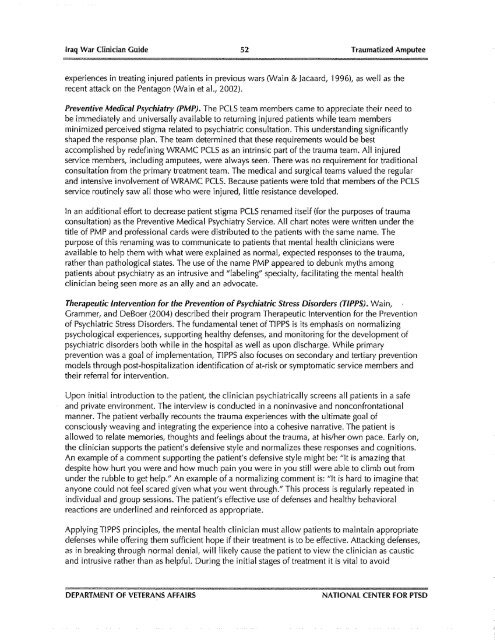IRAQ WAR CLINICIAN GUIDE
Iraq War Clinician's Guide - Network Of Care
Iraq War Clinician's Guide - Network Of Care
You also want an ePaper? Increase the reach of your titles
YUMPU automatically turns print PDFs into web optimized ePapers that Google loves.
-Iraq War Clinician Guide 52 Traumatized Amputee<br />
-<br />
experiences in treating injured patients in previous wars (Wain & Jacaard, 19961, as well as the<br />
recent attack on the Pentagon (Wain et al., 2002).<br />
Preventive Medical Psychiatry (PMP). The PCLS team members came to appreciate their need to<br />
be immediately and universally available to returning injured patients while team members<br />
minimized perceived stigma related to psychiatric consultation. This understanding significantly<br />
shaped the response plan. The team determined that these requirements would be best<br />
accomplished by redefining WRAMC PCLS as an intrinsic part of the trauma team. All injured<br />
service members, including amputees, were always seen. There was no requirement for traditional<br />
consultat(on from the primary treatment team. The medical and surgical teams valued the regular<br />
and intensive involvement of WRAMC PCLS. Because patients were told that members of the PCLS<br />
service routinely saw all those who were injured, little resistance developed.<br />
In an additional effort to decrease patient stigma PCLS renamed itself (for the purposes of trauma<br />
consultation) as the Preventive Medical Psychiatry Service. All chart notes were written under the<br />
title of PMP and professional cards were distributed to the patients with the same name. The<br />
purpose of this renaming was to communicate to patients that mental health clinicians were<br />
available to help them with what were explained as normal, expected responses to the trauma,<br />
rather than pathological states. The use of the name PMP appeared to debunk myths among<br />
patients about psychiatry as an intrusive and "labeling" specialty, facilitating the mental health<br />
clinician being seen more as an ally and an advocate.<br />
Therapeutic lntervention for the Prevention of Psychiatric Stress Disorders WPPS). Wain, .<br />
Crammer, and DeBoer (2004) described their program Therapeutic lntervention for the Prevention<br />
of Psychiatric Stress Disorders. The fundamental tenet of TlPPS is its emphasis on normalizing<br />
psychological experiences, supporting healthy defenses, and monitoring for the development of<br />
psychiatric disorders both while in the hospital as well as upon discharge. While primary<br />
prevention was a goal of implementation, TlPPS also focuses on secondary and tertiary prevention<br />
models through post-hospitalization identification of at-risk or symptomatic service members and<br />
their referral for intervention.<br />
Upon initial introduction to the patient, the clinician psychiatrically screens all patients in a safe<br />
and private environment. The interview is conducted in a noninvasive and nonconfrontational<br />
manner. The patient verbally recounts the trauma experiences with the ultimate goal of<br />
consciously weaving and integrating the experience into a cohesive narrative. The patient is<br />
allowed to relate memories, thoughts and feelings about the trauma, at hislher own pace. Early on,<br />
the clinician supports the patient's defensive style and normalizes these responses and cognitions.<br />
An example of a comment supporting the patient's defensive style might be: "It is amazing that<br />
despite how hurt you were and how much pain you were in you still were able to climb out from<br />
under the rubble to get help." An example of a normalizing comment is: "It is hard to imagine that<br />
anyone could not feel scared given what you went through." This process is regularly repeated in<br />
individual and group sessions. The patient's effective use of defenses and healthy behavioral<br />
reactions are underlined and reinforced as appropriate.<br />
Applying TlPPS principles, the mental health clinician must allow patients to maintain appropriate<br />
defenses while offering them sufficient hope if their treatment is to be effective. Attacking defenses,<br />
as in breaking through normal denial, will likely cause the patient to view the clinician as caustic<br />
and intrusive rather than as helpful. During the initial stages of treatment it is vital to avoid<br />
DEPARTMENT OF VETERANS AFFAIRS<br />
NATIONAL CENTER FOR PTSD




